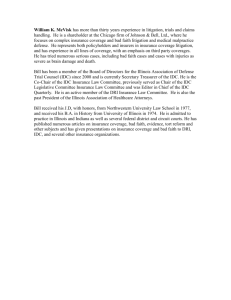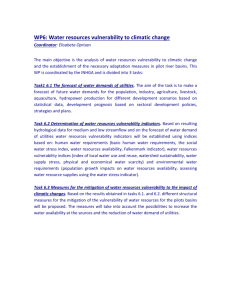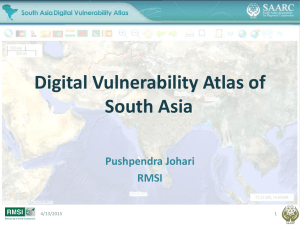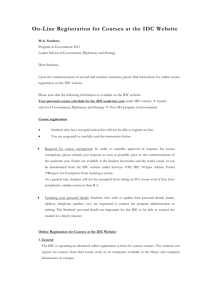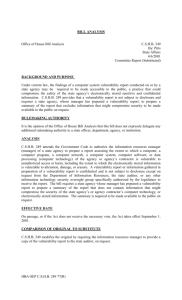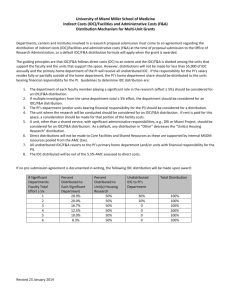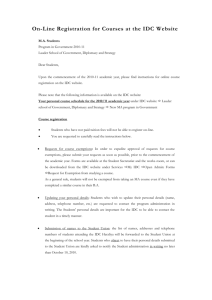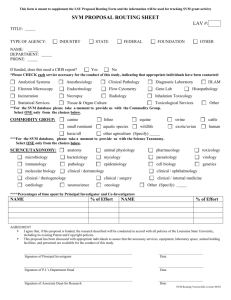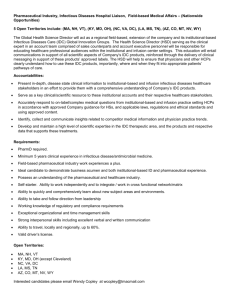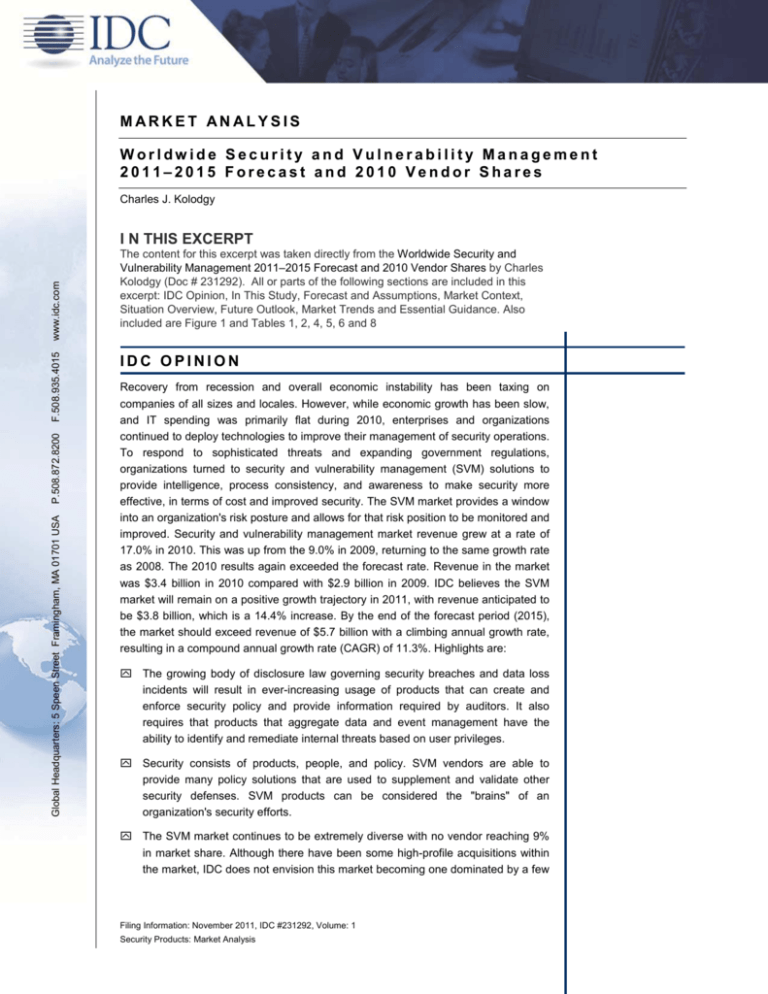
MARKET AN ALYSIS
Worldwide Security and Vulnerability Management
2011–2015 Forecast and 2010 Vendor Shares
Charles J. Kolodgy
Global Headquarters: 5 Speen Street Framingham, MA 01701 USA
P.508.872.8200
F.508.935.4015
www.idc.com
I N THIS EXCERPT
The content for this excerpt was taken directly from the Worldwide Security and
Vulnerability Management 2011–2015 Forecast and 2010 Vendor Shares by Charles
Kolodgy (Doc # 231292). All or parts of the following sections are included in this
excerpt: IDC Opinion, In This Study, Forecast and Assumptions, Market Context,
Situation Overview, Future Outlook, Market Trends and Essential Guidance. Also
included are Figure 1 and Tables 1, 2, 4, 5, 6 and 8
IDC OPINION
Recovery from recession and overall economic instability has been taxing on
companies of all sizes and locales. However, while economic growth has been slow,
and IT spending was primarily flat during 2010, enterprises and organizations
continued to deploy technologies to improve their management of security operations.
To respond to sophisticated threats and expanding government regulations,
organizations turned to security and vulnerability management (SVM) solutions to
provide intelligence, process consistency, and awareness to make security more
effective, in terms of cost and improved security. The SVM market provides a window
into an organization's risk posture and allows for that risk position to be monitored and
improved. Security and vulnerability management market revenue grew at a rate of
17.0% in 2010. This was up from the 9.0% in 2009, returning to the same growth rate
as 2008. The 2010 results again exceeded the forecast rate. Revenue in the market
was $3.4 billion in 2010 compared with $2.9 billion in 2009. IDC believes the SVM
market will remain on a positive growth trajectory in 2011, with revenue anticipated to
be $3.8 billion, which is a 14.4% increase. By the end of the forecast period (2015),
the market should exceed revenue of $5.7 billion with a climbing annual growth rate,
resulting in a compound annual growth rate (CAGR) of 11.3%. Highlights are:
ִ The growing body of disclosure law governing security breaches and data loss
incidents will result in ever-increasing usage of products that can create and
enforce security policy and provide information required by auditors. It also
requires that products that aggregate data and event management have the
ability to identify and remediate internal threats based on user privileges.
ִ Security consists of products, people, and policy. SVM vendors are able to
provide many policy solutions that are used to supplement and validate other
security defenses. SVM products can be considered the "brains" of an
organization's security efforts.
ִ The SVM market continues to be extremely diverse with no vendor reaching 9%
in market share. Although there have been some high-profile acquisitions within
the market, IDC does not envision this market becoming one dominated by a few
Filing Information: November 2011, IDC #231292, Volume: 1
Security Products: Market Analysis
players, so IDC would not expect any one company to exceed 13% in market
share during this period. The market is too diverse for such a consolidation.
ִ SVM products will continue to benefit from increasing threats from organized
attackers. SVM solutions help organizations identify weaknesses (vulnerabilities
and policies), gain a full picture of what is going on (security intelligence and
event management [SIEM] and forensics), and provide visibility of those issues to
the executive team.
IN THIS STUDY
This IDC study examines the security and vulnerability management market for the
2010–2015 period, with vendor revenue trends and market growth forecasts.
Worldwide market sizes and vendor revenue and market shares of the leading
vendors are provided for 2010, and a five-year growth forecast for this market is
shown for 2011–2015. This study concludes with market trends and IDC guidance for
future success.
Security and Vulnerability Management
Market Definitions
The security and vulnerability management market encompasses two separate but
symbiotic markets — security management and vulnerability assessment. These two
markets can stand alone, but they also have considerable overlap in how they are
used by enterprises. There are seven subcategories divided between security
management and vulnerability assessment. The markets and submarkets are defined
as follows:
ִ Vulnerability assessment products. These are batch-level products that scan
servers, workstations, other devices, and applications to uncover security
vulnerabilities be they associated with known security holes (vulnerabilities)
contained within a vulnerability database, or are configuration settings that can
be exploited. These scans provide a view of the threat status of the device or an
application. More sophisticated VA products can test for unknown vulnerabilities
by mimicking common attack profiles to see if a device or an application can be
penetrated. The use of penetration testing is an advanced capability that allows
you to safely exploit vulnerabilities by replicating the kinds of access an intruder
could achieve and providing actual paths of attacks that must be eliminated.
Penetration testing, when used in conjunction with vulnerability scanning,
reduces the number of false positives. Vulnerability assessment products are
additionally segmented as defined here:
#231292
Device vulnerability assessment products. Device vulnerability
assessment products use either network- or host-based scanners to look
into a device to determine the security vulnerabilities. These scanners
search out and discover devices and try to find known vulnerabilities on
target systems. They can have credentialed access (using usernames and
passwords) into devices or provide an uncredentialed (hacker's view) look at
©2011 IDC
a device. Credentialed scanners can do a deep dive into the device to find
known vulnerabilities, while the hacker view will simulate attacks to see if a
device can actually be exploited. Device VA scanners generally operate
anonymously.
Application scanners. Application scanners are products specifically
designed to test the robustness of an application or software to resist attacks
— both specific attacks and attacks based on hacking techniques.
Application scanners avoid doing general vulnerability checks, such as port
scans, or patch checks to concentrate on vulnerabilities associated with
direct interaction with applications. The application scanner market includes
products that look at deployed applications and products that review source
code.
SITUATION OVERVIEW
Security and Vulnerability Management
Market in 2010
Products that fall within the security and vulnerability management market remain in
high demand. The SVM market covers a wide area of solutions that are designed to
provide the brains of the security organization. Organizations look for solutions to
proactively mitigate risk, create and audit security policy, consolidate risk
management information, and ultimately, provide some security peace of mind. As a
result, the market had a 17% growth rate in 2010 compared with 2009's results. The
total market in 2010 was $3.4 billion. With over 50 named vendors, even following all
of the merger and acquisition (M&A) activity, the SVM market is large and
competitive. Unlike some other security markets that are dominated by a handful of
vendors, no single leading vendor reaches 9% in market share. It takes 14 different
vendors to accumulate 50% of the total market. This is down one vendor from what
was required in 2009 to reach the same number.
To illustrate the complexity and competitiveness of this market, Table 1 provides a
collection of select vendors and their products as they fit into the market
subcategories. Please understand this is a representative list and does not include
every product a vendor has that falls within the SVM market.
TABLE 1
Representative SVM Vendor Products for Select Vendors
Company
EMC
©2011 IDC
Proactive
Endpoint Risk
Management
Forensics and
Incident
Investigation
Policy and
Compliance
NetWitness
Spectrum
Archer eGRC
Suite
#231292
Security
Intelligence and
Event
Management
Security
Device
Systems
Management
Vulnerability
Assessment
enVision
3
TABLE 1
Representative SVM Vendor Products for Select Vendors
Company
Proactive
Endpoint Risk
Management
Forensics and
Incident
Investigation
Enterasys
Networks
Policy and
Compliance
NMS Policy
Manager
GFI
Guidance
Software
EnCase
Cybersecurity
HP
IBM
Tivoli Endpoint
Manager for
Security and
Compliance
Imperva
Lumension
Security
4
Lumension
Patch and
Remediation;
Lumension
Security
Configuration
Management
EnCase
Forensic
Security
Intelligence and
Event
Management
Security
Device
Systems
Management
Security
Information and
Event Manager
NMS
Inventory
Manager;
NMS Console
Vulnerability
Assessment
GFI
EventsManager
GFI LANguard
Compliance
Insight
Packages
ArcSight ESM;
ArcSight Logger
Fortify RealTime Analyzer;
Fortify Static
Code Analyzer
Tivoli Security
Compliance
Manager; Tivoli
Security Policy
Manager;
Guardium
Database
Activity
Monitoring
Tivoli Security
Information and
Event Manager
Proventia
Network
Scanner;
Rational
AppScan;
zSecure Audit;
Guardium
Database
Vulnerability
Assessment
EnCase
Enterprise
SecureSphere
Database
Activity
Monitoring; File
Activity
Monitoring
SecureSphere
Discovery and
Assessment
Server
Lumension
Risk Manager
Lumension
Scan
#231292
©2011 IDC
TABLE 1
Representative SVM Vendor Products for Select Vendors
Company
Proactive
Endpoint Risk
Management
Forensics and
Incident
Investigation
Policy and
Compliance
McAfee
McAfee Total
Protection for
Compliance;
McAfee
Configuration
Control
Policy Auditor;
Network User
Behavior
Analysis;
ePolicy
Orchestrator
Microsoft
Windows
Server Update
Services
Systems
Center
Configuration
Manager
NetIQ
Change
Guardian
VigilEnt Policy
Center
NIKSUN
NetDetector;
NetIntercept
Security
Intelligence and
Event
Management
Risk Advisor
Security
Device
Systems
Management
Vulnerability
Assessment
Vulnerability
Manager;
Vulnerability
Assessment
SaaS
Baseline
Security
Analyzer;
SCCM
Vulnerability
Assessment
Configuration
Pack
NetIQ Security
Manager
NetIQ Secure
Configuration
Manager
NetOmni
Q1 Labs
(bought by
IBM)
QRadar
Qualys
QualysGuard
PC
QualysGuard
VM;
QualysGuard
WebApplication
Scanning
Symantec
Critical System
Protection;
Altiris Client
Management
Suite
Control
Compliance
Suite
Security
Information
Manager;
DeepSight Early
Warning
Tripwire
Tripwire
Enterprise
Remediation
Manager
Tripwire
Enterprise
Policy Manager
Tripwire Log
Center
Risk
Automation
Suite
Source: IDC, 2011
©2011 IDC
#231292
5
Table 4 displays 2010 worldwide revenue and market shares for vulnerability
assessment vendors.
Figure 6 displays 2010 market shares for the top 5 device vulnerability assessment
vendors and application vulnerability assessment vendors, respectively.
6
#231292
©2011 IDC
TABLE 2
Worldwide Security and Vulnerability Management Revenue by Vendor,
2010 ($M)
2010
IBM
212.4
286.5
8.5
34.9
HP
219.5
280.1
8.3
27.6
Symantec
195.0
207.2
6.2
6.3
EMC
125.4
135.2
4.0
7.8
Microsoft
90.0
92.0
2.7
2.2
NetIQ (an Attachmate company)
81.8
88.7
2.6
8.4
McAfee
93.2
88.5
2.6
-5.1
Guidance
65.9
80.0
2.4
21.5
Fujitsu
63.9
78.5
2.3
22.9
Lumension
71.4
76.4
2.3
7.0
Q1 Labs (bought by IBM)
48.5
76.1
2.3
56.9
Enterasys
64.4
73.2
2.2
13.6
Tripwire
60.0
66.0
2.0
10.0
Qualys
57.6
65.4
1.9
13.5
Cisco
94.4
61.1
1.8
-35.3
LogLogic
41.0
53.3
1.6
30.0
NIKSUN
39.4
41.8
1.2
6.1
Check Point
32.3
41.2
1.2
27.6
GFI
34.0
37.4
1.1
10.0
Imperva
27.0
35.8
1.1
32.6
LANDesk
23.1
34.6
1.0
49.6
SecureWorks (bought by Dell)
31.8
33.9
1.0
6.6
Trustwave
17.2
33.4
1.0
94.2
Shavlik (bought by VMware)
46.1
32.0
1.0
-30.6
Hitachi
29.0
31.6
0.9
8.9
Application Security
25.4
29.2
0.9
15.0
Cenzic
18.0
28.6
0.8
58.9
CA Technologies
29.4
28.1
0.8
-4.6
Nitro Security (bought by McAfee)
16.8
27.6
0.8
64.3
©2011 IDC
#231292
2010 Share (%)
2009–2010
Growth (%)
2009
7
TABLE 2
Worldwide Security and Vulnerability Management Revenue by Vendor,
2010 ($M)
2010
NetWitness (bought by EMC)
19.7
26.2
0.8
33.0
nCircle
21.9
25.8
0.8
17.8
Core Security
20.0
25.2
0.7
26.0
Tenable Network Security
18.0
24.3
0.7
35.0
Novell (bought by Attachmate)
29.9
23.8
0.7
-20.4
Rapid7
11.2
19.0
0.6
69.6
8.0
18.2
0.5
127.5
Accuvant
13.0
18.0
0.5
38.5
Kaseya
14.0
17.8
0.5
27.1
NEC
13.1
16.8
0.5
28.6
NGS Secure
12.0
16.5
0.5
37.5
Tufin
12.7
16.1
0.5
26.8
LogRhythm
11.0
16.0
0.5
45.5
AccessData
11.0
15.0
0.4
36.4
eIQnetworks Inc.
14.5
15.0
0.4
3.4
Solera Networks
4.0
15.0
0.4
275.0
19.5
14.8
0.4
-24.1
6.1
9.5
0.3
55.7
11.0
9.0
0.3
-18.2
SenSage
6.0
8.0
0.2
33.3
CSC
7.0
7.5
0.2
7.1
11.9
7.2
0.2
-39.5
MANDIANT
5.0
7.0
0.2
40.0
RedSeal
6.0
7.0
0.2
16.7
Dell
6.4
6.7
0.2
4.7
Intrusion.com
4.9
5.6
0.2
14.3
Entrust Inc.
4.5
5.3
0.2
17.8
Acunetix
4.0
5.0
0.1
25.0
Blue Lance
4.0
5.0
0.1
25.0
eEye
netForensics
WhiteHat
TriGeo (bought by SolarWinds)
Secunia
8
#231292
2010 Share (%)
2009–2010
Growth (%)
2009
©2011 IDC
TABLE 2
Worldwide Security and Vulnerability Management Revenue by Vendor,
2010 ($M)
Subtotal
Other
Total
2010 Share (%)
2009–2010
Growth (%)
2,649.7
78.7
16.0
591.6
715.5
21.3
20.9
2,875.8
3,365.2
100.0
17.0
2009
2010
2,284.2
Source: IDC, 2011
©2011 IDC
#231292
9
TABLE 4
Worldwide Vulnerability Assessment Revenue by Vendor, 2010
Revenue ($M)
Share (%)
IBM
86.5
11.4
Qualys
62.8
8.3
HP
55.0
7.2
McAfee
33.1
4.4
Cenzic
28.6
3.8
Symantec
26.9
3.5
Core Security
25.2
3.3
GFI
24.3
3.2
nCircle
22.4
2.9
Tenable Network Security
21.4
2.8
Microsoft
20.3
2.7
Rapid7
19.0
2.5
Lumension
18.7
2.5
eEye
15.0
2.0
Imperva
14.4
1.9
NGS Secure
13.5
1.8
Application Security
12.2
1.6
WhiteHat
9.5
1.2
Trustwave
9.1
1.2
CSC
7.5
1.0
Secunia
7.2
0.9
Shavlik (bought by VMware)
6.0
0.8
Acunetix
5.0
0.7
NetIQ (an Attachmate company)
4.2
0.6
CA Technologies
4.1
0.5
Blue Lance
0.5
0.1
Subtotal
552.4
72.6
Other
208.2
27.4
Total
760.6
100.0
Source: IDC, 2011
10
#231292
©2011 IDC
FIGURE 6
Worldwide Device Vulnerability Assessment Revenue Share by
Vendor, 2010
Source: IDC, 2011
FUTURE OUTLOOK
Forecast and Assumptions
Worldwide revenue for the SVM market reached $3.4 billion in 2010, representing
17.0% growth over 2009. IDC currently forecasts that the SVM market will increase at
an 11.3% CAGR and reach $5.7 billion in 2015, as shown in Table 5.
TABLE 5
Worldwide Security and Vulnerability Management Revenue by Segment,
2009–2015 ($M)
2010–2015
CAGR (%)
2009
2010
2011
2012
2013
2014
2015
Security intelligence and
event management
826.2
1,056.8
1,281.1
1,515.4
1,757.5
1,971.7
2,153.0
15.3
Proactive endpoint risk
management
384.5
415.1
449.5
484.1
517.6
548.5
576.4
6.8
Forensics and incident
investigation
142.0
188.7
234.1
276.6
322.2
366.5
410.5
16.8
Security management
©2011 IDC
#231292
11
TABLE 5
Worldwide Security and Vulnerability Management Revenue by Segment,
2009–2015 ($M)
2010–2015
CAGR (%)
2009
2010
2011
2012
2013
2014
2015
Policy and compliance
536.1
688.5
802.9
906.6
1,008.6
1,098.4
1,179.8
11.4
Security device systems
management
295.1
255.6
238.1
225.1
217.1
214.9
214.9
-3.4
2,183.9
2,604.7
3,005.8
3,407.7
3,822.9
4,199.9
4,534.5
11.7
Device
398.3
412.7
433.3
460.2
491.0
525.9
554.8
6.1
Application
293.6
347.9
410.6
472.9
533.7
594.0
655.3
13.5
Subtotal
691.9
760.6
843.9
933.1
1,024.8
1,119.9
1,210.2
9.7
2,875.8
3,365.3
3,849.7
4,340.9
4,847.7
5,319.8
5,744.7
11.3
Subtotal
Vulnerability assessment
Total
Note: See Table 6 for top 3 assumptions and Table 7 for key forecast assumptions.
Source: IDC, 2011
Tables 6 and 7 show the top 3 assumptions and the key forecast assumptions,
respectively, which provide the basis for the worldwide security and vulnerability
market forecast for 2011–2015.
Market Context
Table 8 and Figure 8 show a comparison of IDC's current forecast with the forecast
published in Worldwide Security and Vulnerability Management 2010–2014 Forecast
and 2009 Vendor Shares (IDC #225988, December 2010). SVM has withstood the
economic downturn better than expected, so the forecast is slightly higher than that
published previously. Growth for submarkets that can demonstrate definitive value to
the organization and provides regulatory compliance will be strong. Products that
reduce costs through automation will also see strong investment.
12
#231292
©2011 IDC
TABLE 8
Worldwide Security and Vulnerability Management Revenue, 2006–2015:
Comparison of December 2010 and November 2011 Forecasts ($M)
2006
2007
2008
2009
2010
2011
2012
2013
2014
2015
November
2011 forecast
1,885.9
2,251.6
2,634.5
2,875.8
3,365.3
3,849.7
4,340.9
4,847.7
5,319.8
5,744.7
Growth (%)
NA
19.4
17.0
9.2
17.0
14.4
12.8
11.7
9.7
8.0
December
2010 forecast
1,885.9
2,251.6
2,634.5
2,875.8
3,158.9
3,553.6
4,020.7
4,554.2
5,168.5
NA
Growth (%)
NA
19.4
17.0
9.2
9.8
12.5
13.1
13.3
13.5
NA
Notes:
See Worldwide Security and Vulnerability Management 2010–2014 Forecast and 2009 Vendor Shares (IDC #225988,
December 2010) for prior forecast.
Historical market values presented here are as published in prior IDC documents based on the market taxonomies and
current U.S. dollar exchange rates existing at the time the data was originally published. For more details, see the
Methodology in the Learn More section.
Source: IDC, 2011
FIGURE 8
Worldwide Security and Vulnerability Management Revenue,
2006–2015: Comparison of December 2010 and November
2011 Forecasts
Source: IDC, 2011
©2011 IDC
#231292
13
Market Trends
Given the importance of risk management, government regulations, and exposure
through vulnerabilities, the security and vulnerability management market is full of
opportunity. Developments that will shape this market in the future include the
following:
ִ Multiple delivery systems. Vendors are providing SVM products using various
delivery methods. These include software, hardware, software as a service, and
virtualized software. The vulnerability assessment market has been available
through SaaS for many years. The use of SaaS for application testing continues
to grow. SaaS is also growing in the SIEM market, and there is no reason SaaS
can't be used in the policy and compliance market. Hardware products are most
prominent in the SIEM and forensics and incident investigation submarkets
because of the need to store vast amounts of log data. Additionally, nearly any of
the SVM submarkets can also employ software appliances to run in a hypervisorbased environment. IDC would expect that SVM products will continue to be
delivered in a diverse manner.
ִ Cloud. Cloud infrastructures are growing in popularity, but one of the things
holding more deployment is security concerns. Organizations are concerned
about the security of the devices that their material will be processed on and
stored in. To deal with these fears, cloud providers are beginning to work with
SVM vendors to allow customers to assess the security posture of the cloud
infrastructure they will be utilizing. For ease of use, the cloud infrastructure
vendors are turning to cloud security providers so that there is consistency
regarding the scans, assessments, and reporting. In this way, they are using the
cloud to protect the cloud.
ִ Application and software security vulnerability assessment. As security
becomes more important at the application level, organizations are demanding
software that is less vulnerable to attack; thus, application-level security needs to
be a fundamental component for software development and quality assurance.
There are application scanning tools that look at operational products such as
databases and Web servers, and in the future, there will be code scanning of
individual mobile apps. The market has been moving from individual static and
dynamic testing products to hybrid solutions that can offer both capabilities. IDC
refers to this as "measuring twice and cutting once." Products within this market will
continue to evolve to the point where they will be used throughout the software
development life cycle so that vulnerabilities can be eliminated before a program
becomes operational.
ִ Situational awareness and analytics. Organizations are looking for ways of
optimizing their security infrastructure to cost effectively deal with real threats.
Organizations are also seeking to extract more value out of regulatory
compliance structure initially built for internal compliance and IT protection to use
it for a basis of best practices to ratchet up not only enforcement but also auditing
mechanisms. SVM technologies provide the knowledge and intelligence, allowing
IT professionals to coordinate people, products, and policy. There has been a
growing movement toward using SIEM technology to provide organizations with
14
#231292
©2011 IDC
"situational awareness," that is to bring information together in order to
understand how information, events, and your own actions will impact your goals
and objectives. Many SIEM vendors, such as eIQnetworks, NitroSecurity, and
EMC, state how their products put security events into context, thus being able to
better find real problems. Both IBM and HP are pushing analytics to take security
events and start to predict what will be coming next. Both situational awareness
and analytics are designed to facilitate better decision making by security
professionals and executives.
ִ Acquisitions. In most markets, smaller vendors with interesting technology will
be purchased by larger players. This has been happening with regularity over the
past few years within the SVM market. Recent acquisitions include EMC's
purchases of Archer and NetWitness, IBM's purchases of BigFix and Q1 Labs,
HP's purchases of Fortify and ArcSight, Dell's purchases of KACE and
SecureWorks, Attachmate's deal for Novell, and Trustwave's purchase of
Intellitactics. Most of the purchases are to provide the acquiring vendor products
that they did not have. However, part of the reason for consolidation is that
customers are reducing the number of vendors they purchase from and are
looking for solutions that work together. Even with this consolidation, IDC does
not expect the market to have just a few dominant players. The market is too
diverse, has too many needs, and is always evolving along with the threat
landscape. Over the years the number of vendors will shrink and a few vendors
will gain larger portions of the market, but in the short term this will not drastically
change the diversity within the market. It will take time for this consolidation.
ESSENTIAL GUIDANCE
Security is a value-add, not just a necessary evil or the purview of the paranoid.
Companies understand that their systems, storage operations, network connectivity,
and endpoints need to be inherently secure. Customers demand security
management that is well integrated with the IT infrastructure, effective, usable, and
affordable. Security and vulnerability management is very important to meeting risk
management goals because it provides policy and compliance context, vulnerability
information, remediation, and ultimately, a comprehensive view of enterprise risk
management. It offers organizations better ways to cost effectively provide risk
management and automate the rising cost of compliance activities. SVM solutions
can simplify the complexity associated with managing multiple security solutions while
at the same time increasing the automation, effectiveness, and proactive nature of
security. Vendors are growing the capabilities to provide comprehensive coverage
within their security management offerings. The key to success in this space will be
the ability to provide proactive security protection and the knowledge and intelligence
to provide comprehensive security assessment data.
IDC believes vendors should develop tools that bring together event records,
efficiently prioritize incidents, separate real security violations from false alarms, and
aggregate security events from different locations, devices, and manufacturers.
Moreover, vulnerabilities must be viewed as part of an overall security management
infrastructure that takes into account security policy, compliance, and risk
management. SVM solutions should tell the enterprise why the vulnerability is a
©2011 IDC
#231292
15
concern, its risk ranking, and how to remediate. SVM offerings must be able to
provide a more aggressive, positive security model and not just respond to events in
a chaotic manner. In many cases, SVM solutions, especially in the proactive endpoint
risk management category, are moving to the point where the product will
automatically remediate any security problems that should develop. Over time, SVM
vendors need to combine their SVM agent with their own endpoint security solutions
to provide all endpoint security capabilities, or the SVM vendor will need to partner
with an endpoint security vendor that does not have SVM capabilities itself.
For the SVM market to maintain its strong growth rates, vendors must continue to
make security smart. This includes providing proper policy management to
automatically enforce the security policy. IDC sees the PERM market as a market that
can bring considerable positive security value to enterprises. Another area where
SVM makes security smart is in the SIEM market, where an ever-growing set of
security data has to be processed to find the critical information among a huge set of
data and to put that intelligence into its proper context. The SIEM market is important
for providing audit information and ensuring proper utilization of security technologies.
IDC also believes that vulnerability scanning, be it device or application based, white
box or black box, credential or hacker view, provides critical information that allows
organizations to adjust their security position to meet real security threats. IDC
believes that products that can do real-time penetration testing will see considerable
success over the next few years because they can pinpoint specific security gaps.
Copyright Notice
This IDC research document was published as part of an IDC continuous intelligence
service, providing written research, analyst interactions, telebriefings, and
conferences. Visit www.idc.com to learn more about IDC subscription and consulting
services. To view a list of IDC offices worldwide, visit www.idc.com/offices. Please
contact the IDC Hotline at 800.343.4952, ext. 7988 (or +1.508.988.7988) or
sales@idc.com for information on applying the price of this document toward the
purchase of an IDC service or for information on additional copies or Web rights.
Copyright 2011 IDC. Reproduction is forbidden unless authorized. All rights reserved.
16
#231292
©2011 IDC

